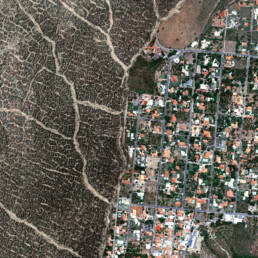Starting with the beginning of the Agricultural Revolution 15,000 years ago, mankind has proved to be the first known case of an animal species able to act on the planet that hosts it, instead of solely react to the changes of the ecosystem. It began an epoch of significant human impact on Earth, which we extremely experience nowadays. The latter has been defined as Anthropocene by several scholars in the past century.
In the last decades, with the beginning of space exploration, mankind has started to impact not just the Earth, but the entire Universe. Wernher Von Braun we had, who in 1942 launched the first missiles that managed to leave the atmosphere. We had the Sputnik 1 in 1957, the first object launched into orbit, Jurij Gagarin in 1961 in the first human outer space flight and Neil Armstrong in 1969: the first human to step onto the surface of the Moon. Space missions have brought consequences for the Universe, but we may consider such impact in the same way as we look at the active effect of every living creature on Earth: not very substantial.
On the contrary, human beings have distorted the ordinary functioning of Earth’s ecosystem becoming the main actors of a prodigious socio-technological evolution. Nevertheless, some of these developments have resulted in the uncoverable ruin of the planet that host us. Nowadays, it is generally accepted that we need more resources than our planet can offer, and latest theories suggest that mankind should become a wandering multi-planetary species in order to survive and, eventually, to save Earth’s ecosystem.
Fifty years ago the main chapter of the Moon race was written. The highest point of a project born to challenge the limits of mankind, to develop technologies for the cold war and to collect data about the resources that the satellite could provide us. After sevenmissions and several years of research, the Moon turned out to be not so interesting and the Apollo program was abandoned in the favour of the Space Shuttle development.
We discovered that the Moon is not so friendly to life-forms and that there’s not so much to learn from it. In recent years, there is a new interest for it with an eye towards luxury tourism. Elon Musk has recently announced the first ticket for a SpaceX flight to the Moon was sold. Other projects plan to use our satellite to host factories and dumps, in order to not compromise our planet more than it has already been done. This would lead to the start of the Anthropocene era also for the Moon.
Nevertheless, nowadays the real challenge is to find a planet, and possibly more, to establish a colony. This would ensure better chance of survival for mankind and eventually decrease its impact on Earth’s ecosystem.
Since planets equal to Earth are too far apart to be reached, it turns out that the best option is to terraform Mars in order to make it inhabitable. Elon Musk, one of the leading figures of the Mars race, has some ideas about it. Because the planet has ice caps on the poles, the basic concept is to melt them down to produce water in liquid and gaseous state in order to produce an atmosphere. The result can be achieved thanks to giant mirrors orbiting the planet that would reflect and concentrate sunlight to the poles. Otherwise, the latest theories suggest that the best option is to drop nuclear bombs on Mars.
Once we’ll have liquid water and an atmosphere on a planet, we could “easily” live there. Meanwhile, the facilities necessary to accommodate the first colonists will be built. That will mean a drastically upheaval of the planet. However, just like every mission of planets exploration, it will not be directly a human to significantly impact on Mars. Until today, Mars exploration has been carried out by machines and so will be for the first steps of the colonization. Therefore, to define such process as the start of the Mars Anthropocene era would be inappropriate. We should rather talk about Anthroporobotocene, considering robot as the term to define a machine that automatically performs tasks on behalf of a man.
The beginning of this new era will mark the second greatest change of human history after the Agricultural Revolution and therefore a crucial breakthrough in the evolution of the species. Speaking of evolution, it’s necessary to highlight the reasons behind such milestones.
As regards the Neolithic Revolution, the latter has been the result of the onset of a complex social stratification which allowed the first stable settlements. It could be argued that the capability to create a community was the keystone of the human evolution.
But, when it comes to the colonization of other planets, what has led us to such a crucial breakthrough? As it has been said, the space race often involved the use of robots, within the meaning previously given. And that’s precisely the point. The ability to design a tool that performs tasks in our place is the keystone that allow us to achieve a new milestone in our evolutionary pathway. A journey that draw a line from the tool-use capability, through the invention of the wheel and the process of domestication, up to the URSS Mars 3, the first robotic space probe to land on Mars in 1971.
However, we do not simply design robots on the foundations of ergonomics, as we do for every other product or structure, we give them anthropomorphic characteristics in order to create something in our image and likeness. Therefore, we can look at the design process of a robot as the genesis of a creature meant to push the boundaries of mankind to a no-more-only-human race. It’s a common belief that in the future robots will live among us, but if we refer to the dawn of a Mars society that might occur in near future, is even more appropriate to assume that people will live among robots.
Our human-like reputation to such creatures is demonstrated by the empathy we feel for them. In 2013, the news of the Curiosity Rover singing “Happy Birthday”to Itself prompted a deluge of empathy in comment sections around the Internet, although the very fact is evidence of the humanization of the robot. The same happened in 2019, when the news has been leaked about the last words from the Opportunity. As a Martian storm descended and the skies were choked of all sunlight, the Rover messaged NASA saying: “My battery is low and it’s getting dark.” Such news sparked on Internet a worldwide support and words of consolation for NASA and its engineers.
These acts highlight a sort of gratitude for a creature which spent its energy for the sake of mankind and its future. A future possible because of man’s ability to create.
If the Agricultural Revolution is attributable, in a sense, to the human capacity of socialize, the emergence of a multi-planetary society will be ascribed to man’s propensity to design. A capability that separates and rises us from other animals and that directly arise from imagination. The same imagination that allow us, while we look ahead at the starlit sky, to dream up a future in which we will inhabit one of those celestial bodies.
The capability to establish communities has allowed us to conquer the world becoming the despot of Planet Earth and all living creatures. Once we exercised such ius vitæ ac necis the hard way, we realized to be faced with a choice: reverse the thousand-year-old trend of ecosystem destruction, or find another place to establish with our unique, intrusive, detrimental modus operandi.
The power of design and the tool of the project will allow us to reach the sky which we have always looked at. Eventually, when we will fully realize the power that comes from the capability to create ex novo we will be taught the burden that comes with it. Hopefully, by then we will be in another, virgin, planet engrossed in the second attempt to establish a society. This once, made of robots and people.
Terraforming Mars: the beginning of Anthroporobotocene © Francesco Burlando
Reference List
Adams, Douglas. 2002. The Ultimate Hitchhiker’s Guide to the Galaxy ; The Hitchhiker’s Guide to the Galaxy ; The Restaurant at the End of the Universe ; Life, the Universe, and Everything ; So Long, and Thanks for All the Fish ; Mostly Harmless. New York: Del Rey.
Asimov, Isaac. 2018. I, Robot. New York: Harpercollins.
Bowie, David. 1969. Space Oddity. London: Trident Studios
Cingolani, Roberto, and Giorgio Metta. 2015. Umani e umanoidi: la nostra vita vita con i robot. Bologna: Il Mulino.
Diamond, Jared. 2019. Guns, Germs and Steel: A Short History of Everybody for the Last 13,000 Years. London: Vintage.
Kubrick, Stanley. 1968. 2001 a space odyssey.
Mason, Ben Young, Everardo Valerio Gout, Justin Wilkes, Andre Bormanis, Mickey Fisher, Karen Janszen, Jonathan Silberberg, et al. 2017.Mars.
Morris, Desmond. 1967. The Naked Ape: A Zoologist’s Study of the Human Animal. London: Jonathan Cape Publishing
Photo Credits
Img 01:
Satellite footage of Seattle, United States, Earth ©2020 DigitalGlobe, U.S. Geological Survey
Satellite footage of Protonilus Mensae, Mars. ©2019NASA/JPL-Caltech/University of Arizona. Editor: Tony Greicius
Pictures have been merged and edited by the author
Img 02:
Satellite footage of Brasilia, Brazil, Earth ©2020 CNES / Astrium, DigitalGlobe
Satellite footage a crater, Mars. ©2017 NASA/JPL-Caltech/University of Arizona. Editor: Tony Greicius
Pictures have been merged and edited by the author
Img 03:
Satellite footage of Herefordshire, United Kingdom, Earth ©2020 Bluesky, Infoterra Ltd & COWI A/S, DigitalGlobe, Getmapping plc, Infoterra Ltd & Bluesky, The GeoInformation Group
Satellite footage of a middle latitude region, Mars. ©2018 NASA/JPL-Caltech/University of Arizona. Editor: Tony Greicius
Pictures have been merged and edited by the author
Francesco Burlando
PhD student in HRI Design. Longing for a world made of two billion people and a decimal time system. Self-centered, narcissist, megalomaniac, touchy and maniacal… but he also has flaws.



